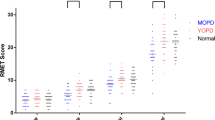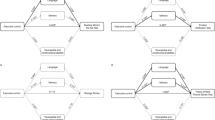Abstract
Theory of Mind is defined as the ability to attribute mental state and emotions to other people and is relevant to social relationships. The cortical and subcortical regions involved in Theory of Mind are damaged by neurodegenerative processes of Parkinsonian syndromes, so the aim of the present study was to explore, for the first time, possible deficits of Theory of Mind and their cognitive correlates in multiple system atrophy (MSA). Twenty-six patients with MSA, 25 patients with Parkinson’s disease (PD) and 25 healthy subjects were enrolled. Cognitive and affective subcomponents of Theory of Mind, executive functions, long-term memory and apathy were evaluated. The three groups did not differ on demographic variables. MSA and PD groups performed worse than healthy subjects on both cognitive (advanced test of ToM) and affective (emotion attribution task) ToM tasks, but no significant difference was found between patients’ groups. However, when using another affective ToM task (Eyes Test), MSA group had poorer performance than healthy subjects and Parkinsonian patients, whereas Parkinsonian patients had similar performance to healthy subjects. Regression analysis revealed an association between poor cognitive flexibility and dysfunctional cognitive component of Theory of Mind. Deficit of cognitive and affective components of Theory of Mind occurred in MSA. Dysfunction of cognitive component was related to executive dysfunction (i.e. cognitive rigidity). These findings might suggest the usefulness of an early evaluation of social cognition in MSA to identify individuals with impaired Theory of Mind who are at risk of social withdrawal, and reduced quality of life.
Similar content being viewed by others
References
Abu-Akel A, Shamay-Tsoory S (2011) Neuroanatomical and neurochemical bases of theory of mind. Neuropsychologia 49(11):2971–2984
Adolphs R (2003a) Cognitive neuroscience of human social behavior. Nat Rev Neurosci 4:165–178
Adolphs R (2003b) Is the human amygdala specialized for processing social information? Ann N Y Acad Sci 985(1):326–340
Adolphs R, Schul R, Tranel D (1998) Intact recognition of facial emotion in Parkinson’s disease. Neuropsychology 12(2):253–258
Baglio F, Castelli I, Alberoni M et al (2012) Theory of mind in amnestic mild cognitive impairment: an fMRI study. J Alzheimer’s Dis 29:25–37
Barbarotto R, Laiacona M, Frosio R et al (1998) A normative study on visual reaction times and two Stroop colour word tests. Ital J Neurol Sci 19:161–170
Baron-Cohen S, Jolliffe T, Mortimore C et al (1997) Another advanced test of theory of mind: evidence from very high functioning adults with autism or Asperger syndrome. J Child Psychol Psychiatry 38:813–822
Blair RJ, Cipolotti L (2000) Impaired social response reversal. A case of ‘acquired sociopathy’. Brain 123:1122–1141
Bodden ME, Mollenhauer B, Trenkwalder C et al (2010) Affective and cognitive theory of mind in patients with Parkinson's disease. Parkinsonism Relat Disord 16(7):466–470
Coundouris SP, Adams AG, Henry JD (2020) Empathy and theory of mind in Parkinson's disease: a meta-analysis. Neurosci Biobehav Rev 109:92–102
de la Fuente-Fernández R (2012) Frontostriatal cognitive staging in Parkinson's disease. Parkinson’s Dis 2012:561046
El Haj M, Raffard S, Gely-Nargeot MC (2015) Destination memory and cognitive theory of mind in normal ageing. Memory 24:526–534
Euteneur F, Schaefer F, Stuermer R et al (2009) Dissociation of decision making under ambiguity and decision making under risk in patients with Parkinson’s disease: a neuropsychological and psychophysiological study. Neuropsychologia 47:2882–2890
Fahn S, Elton RL, Members of the UPDRS Development Committee (1987) The unified Parkinson’s Disease Rating Scale. In: Fahn S, Marsden CD, Calne D, Goldstein M (eds) Recent developments in Parkinson’s disease. Macmillan Healthcare Information, New York, pp 153–304
Frank MJ, O’Reilly RC (2006) A mechanistic account of striatal dopamine function in human cognition: psychopharmacological studies with cabergoline and haloperidol. Behav Neurosci 120:497–517
Frith CD, Frith U (1999) Interacting minds—a biological basis. Science 286(5445):1692–1695
Happé F (1994) An advanced test of theory of mind: understanding of story characters’ thoughts and feelings by able autistic, mentally handicapped, and normal children and adults. J Autism Dev Disord 35(2):129–154
Gibb WR, Lees AJ (1988) The relevance of the Lewy body to the pathogenesis of idiopathic Parkinson's disease. J Neurol Neurosurg Psychiatry 51:745–752
Gilman S, Wenning GK, Low PA et al (2008) Second consensus statement on the diagnosis of multiple system atrophy. Neurology 71(9):670–676
Giovagnoli AR, Del Pesce M, Mascheroni S et al (1996) Trail making test: normative values from 287 normal adult controls. Ital J Neurol Sci 17:305–309
Gotham AM, Brown RG, Marsden CD (1986) Levodopa treatment may benefit or impair "frontal" function in Parkinson's disease. Lancet 2(8513):970–971
Herrmann E, Call J, Hernández-Lloreda M et al (2007) Humans have evolved specialized skills of social cognition: the cultural intelligence hypothesis. Science 317(5843):1360–1366
Kawai Y, Suenaga M, Takeda A et al (2008) Cognitive impairments in multiple system atrophy: MSA-C vs MSA-P. Neurology 70(16 Pt 2):1390–1396
Kim HW, Oh M, Oh JS et al (2017) Striatofrontal deafferentiation in MSA-P: evaluation with [18F] FDG brain PET. PLoS ONE 12(1):e0169928
Litvan I, Goldman JG, Tröster AI et al (2012) Diagnostic criteria for mild cognitive impairment in Parkinson's disease: Movement Disorder Society Task Force guidelines. Mov Disord 27(3):349–356
Marin RS, Biedrzycki RC, Firinciogullari S (1991) Reliability and validity of the Apathy Evaluation Scale. Psychiatry Res 38(2):143–162
McKinlay A, Albicini M, Kavanagh PS (2013) The effect of cognitive status and visuospatial performance on affective theory of mind in Parkinson's disease. Neuropsychiatr Dis Treat 9:1071–1076
Mimura M, Oeda R, Kawamura M (2006) Impaired decision-making in Parkinson’s disease. Parkinsonism Relat Disord 12:169–175
Miyake A, Friedman NP, Emerson MJ et al (2000) The unity and diversity of executive functions and their contributions to complex “frontal lobe” tasks: a latent variable analysis. Cogn Psychol 41:49–100
Novelli G, Papagno C, Capitani E et al (1986) Tre test clinici di memoria verbale a lungo termine. Arch Psicol Neurol Psichiatr 47:278–296
O’Keeffe FM, Murray B, Coen RF et al (2007) Loss of insight in frontotemporal dementia, corticobasal degeneration and progressive supranuclear palsy. Brain 130:753–764
Pardini M, Nichelli PF (2009) Age-related decline in mentalizing skills across adult life span. Exp Aging Res 35:98–106
Peron J, Le Jeune F, Haegelen C et al (2010) Subthalamic nucleus stimulation affects theory of mind network: a PET study in Parkinson’s disease. PLoS ONE 5:e9919
Peron J, Vicente S, Leray E et al (2009) Are dopaminergic pathways involved in theory of mind? A study in Parkinson’s disease. Neuropsychologia 47:406–414
Prior M, Marchi S, Sartori G (2003) Social cognition and behaviour. A tool for assessment. Cognizione sociale e comportamento. Uno strumento per la misurazione. Upsel Domenighini Editore, Padova
Rankin KP, Gorno-Tempini ML, Allison SC et al (2006) Structural anatomy of empathy in neurodegenerative disease. Brain 129:2945–2956
Rankin KP, Santos-Modesitt W, Kramer JH et al (2008) Spontaneous social behaviors discriminate behavioral dementias from psychiatric disorders and other dementias. J Clin Psychiatry 69:60–73
Roca M, Torralva T, Gleichgerrercht E et al (2010) Impairments in social cognition in early medicated and unmedicated Parkinson’s disease. Cogn Behav Neurol 23:152–158
Rosen JB, Brand M, Polzer C, Ebersbach G, Kalbe E (2013) Moral decision-making and theory of mind in patients with idiopathic Parkinson's disease. Neuropsychology 27(5):562–572
Salvesen L, Ullerup BH, Sunay FB et al (2015) Changes in total cell numbers of the basal ganglia in patients with multiple system atrophy—a stereological study. Neurobiol Dis 74:104–113
Salvesen L, Winge K, Brudek T et al (2017) Neocortical neuronal loss in patients with multiple system atrophy: a stereological study. Cereb Cortex 27(1):400–410
Santangelo G, Barone P, Cuoco S et al (2014) Apathy in untreated, de novo patients with Parkinson's disease: validation study of Apathy Evaluation Scale. J Neurol 261(12):2329 (F. Santangelo [corrected to F. Santangelo]]. J Neurol 261(12):2319–2328)
Santangelo G, Cuoco S, Pellecchia MT et al (2018) Comparative cognitive and neuropsychiatric profiles between Parkinson's disease, multiple system atrophy and progressive supranuclear palsy. J Neurol 265(11):2602–2613
Santangelo G, Cuoco S, Picillo M et al (2020) Evolution of neuropsychological profile in motor subtypes of multiple system atrophy. Parkinsonism Relat Disord 70:67–73
Santangelo G, Siciliano M, Pedone R et al (2015) Normative data for the Montreal Cognitive Assessment in an Italian population sample. Neurol Sci 36:585–591
Santangelo G, Vitale C, Trojano L et al (2012) Neuropsychological correlates of theory of mind in patients with early Parkinson's disease. Mov Disord 27(1):98–105
Sica C, Ghisi M (2007) The Italian versions of the Beck Anxiety Inventory and the Beck Depression Inventory-II: Psychometric properties and discriminant power. In: Lange MA (ed) Leading-edge psychological tests and testing research. Nova Science Publishers, New York, pp 27–50
Spinnler H, Tognoni G (1987) Standardizzazione e taratura italiana di test neuropsicologici: Gruppo Italiano per lo Studio Neuropsicologico dell’Invecchiamento. Ital J Neurol Sci 8(Suppl. 8):1–120
Tomlinson CL, Stowe R, Patel S et al (2010) Systematic review of levodopa dose equivalency reporting in Parkinson's disease. Mov Disord 25:2649–2653
Vellante M, Baron-Cohen S, Melis M et al (2013) The “Reading the Mind in the Eyes” test: systematic review of psychometric properties and a validation study in Italy. Cogn Neuropsychiatry 18:326–354
Wenning GK, Tison F, Seppi K et al (2004) Development and validation of the Unified Multiple System Atrophy Rating Scale (UMSARS). Mov Disord 19(12):1391–1402
Funding
GS received salary from the University of Campania Luigi Vanvitelli, Italy. SC received salary from the University of Salerno, Italy. MTP received salary from the University of Salerno, Italy. RE received consultancies from Zambon and honoraria for speaking from Teva. PB received salary from the University of Salerno, Italy. PB Consultancies: Novartis, Schwarz Pharma/UCB, Merck-Serono, Eisai, Solvay, General Electric and Lundbeck; Advisory Boards: Novartis, Schwarz Pharma/UCB, Merck-Serono, Eisai, Solvay, General Electric and Lundbeck; Grants: Research supports from Boehringer Ingelheim, Novartis, Schwarz Pharma/UCB, MerckSerono, Solvay, and Lundbeck. MP received salary from the University of Salerno, Italy.
Author information
Authors and Affiliations
Contributions
GS: (1) Research project: A. Conception, B. Organization, C. Execution; (2) Statistical Analysis: A. Design, B. Execution, C. Review and Critique; (3) Manuscript: A. Writing of the first draft; SC: (1) Research project: C. Execution; (2) Statistical Analysis: C. Review and Critique; (3) Manuscript: B. Review and Critique; MP: (1) Research project: C. Execution; (2) Statistical Analysis: C. Review and Critique; (3) Manuscript: B. Review and Critique; RE: (1) Research project: C. Execution; (2) Statistical Analysis: C. Review and Critique; (3) Manuscript: B. Review and Critique; MS: (1) Research project: C. Execution; (2) Statistical Analysis: C. Review and Critique; (3) Manuscript: B. Review and Critique; GV: (1) Research project: C. Execution; (2) Statistical Analysis: C. Review and Critique; (3) Manuscript: B. Review and Critique; AC: (1) Research project: C. Execution; (2) Statistical Analysis: C. Review and Critique; (3) Manuscript: B. Review and Critique; GC: (1) Research project: C. Execution; (2) Statistical Analysis: C. Review and Critique; (3) Manuscript: B. Review and Critique; PB: (1) Research project: C. Execution; (2) Statistical Analysis: C. Review and Critique; (3) Manuscript: B. Review and Critique; MTP: (1) Research project: A. Conception, B. Organization, C. Execution; (2) Statistical Analysis: C. Review and Critique; (3) Manuscript: A. Writing of the first draft, B. Review and Critique.
Corresponding author
Ethics declarations
Conflict of interest
The authors declare that they have no conflict of interest.
Ethical standards
All participants gave their written informed consent to participate to the study, which was approved by the Local Ethics Committee and was performed in accordance with the ethical standards laid down in the 1964 Declaration of Helsinki and its later amendments.
Additional information
Publisher's Note
Springer Nature remains neutral with regard to jurisdictional claims in published maps and institutional affiliations.
Rights and permissions
About this article
Cite this article
Santangelo, G., Cuoco, S., Picillo, M. et al. Theory of Mind in multiple system atrophy: comparison with Parkinson’s disease and healthy subjects. J Neural Transm 127, 915–923 (2020). https://doi.org/10.1007/s00702-020-02181-3
Received:
Accepted:
Published:
Issue Date:
DOI: https://doi.org/10.1007/s00702-020-02181-3




